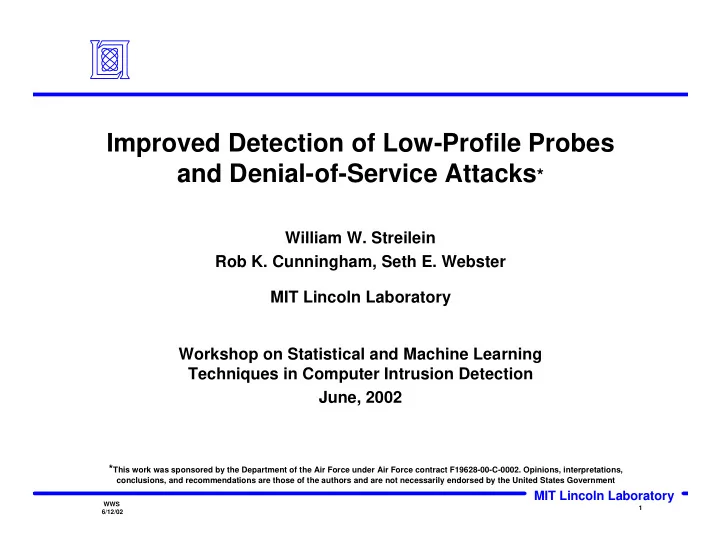

Improved�Detection�of�Low-Profile�Probes� and�Denial-of-Service�Attacks * William�W.�Streilein Rob�K.�Cunningham,�Seth�E.�Webster MIT�Lincoln�Laboratory Workshop�on�Statistical�and�Machine�Learning� Techniques�in�Computer�Intrusion�Detection June,�2002 * This�work�was�sponsored�by�the�Department�of�the�Air�Force�under Air�Force�contract�F19628-00-C-0002.�Opinions,�interpretations,� conclusions,�and�recommendations�are�those�of�the�authors�and�are�not�necessarily�endorsed�by�the�United�States�Government MIT�Lincoln�Laboratory WWS� 1 6/12/02
Outline • Motivation�and�Goals • Overall�System�Design • Data�Structure�Improvements The� Psplice Connection�Library • • Feature�Vector�Improvements – Feature�element�importance • Test�Results�on�1999�DARPA�Evaluation�Data – Methodology – Results:�Probe,�DoS,�Stealth�Detection • Data�Structure�Performance • Summary MIT�Lincoln�Laboratory WWS� 2 6/12/02
Motivation • Network-based�intrusion�detection�remains�an�important� tool�in�detecting�Probes�and�DoS�attacks – More�complete�perspective�on�local�and�remote�network� activities�than�host-based�systems – Can�protect�multiple�devices�at�once – Stealthy�probes�common�precursor�to�attack • Stealthy�probes�use�techniques�designed�to�avoid�detection – DoS�attacks�increasing�in�number�and�distributed�nature • Machine�learning�for�Probe�and�DoS�detection – Learn�to�distinguish�attack�traffic�from�normal�traffic� • Actual�network�data�used�to�train�algorithm – Network�outputs�represent�probabilities�of�detection • Allows�choosing�an�appropriate�output�threshold MIT�Lincoln�Laboratory WWS� 3 6/12/02
Goals • Enhance�Probe�and�DoS�detection�and�performance�of� original�system • Enhance�detection�feature�vector� – Reflect�closer�relationship�to�connection�events�and�improved� event�timing�available�from�Psplice • Detect�new�classes�of�Attacks – Expand�Protocol�Coverage:�ARP,�DHCP – Distributed�DoS,�Probe�attacks • Make�internal�data�structures�less�vulnerable�to�attack – Original�system�uses�hash�tables • Reduce�analyst�workload�through�alert�aggregation – Original�system�produces�new�alert�per�connection MIT�Lincoln�Laboratory WWS� 4 6/12/02
System�Design • Multi-stage�processing�of� connection�events�for�attack� detection • Connection�processing�handled� by�Psplice�library • Feature�extraction�upon�event� time�and�characteristics • Neural�network�classifiers� produce�probability�of�attack • Distributed�attacks�recognized� through�alert�aggregation • Aggregation�of�alerts�reduces� Alert�Aggregation analyst�overload MIT�Lincoln�Laboratory WWS� 5 6/12/02
Psplice • LL-Developed�library�for�tracking�TCP,UDP,�ICMP,�ARP�and�DHCP� connections • Utilizes�libpcap�packet�library • Operates�in�real-time�or�on�capture�file • Summarizes�packet�data�into�OPEN,�DATA�and�CLOSE�connection� events�for�calling�application • Delivers�connection�statistics�and�attribute�flags – ACK�flag,�FIN�flag,�etc. – N�bytes/pkts�to�src,�M�bytes/pkts�to�dest • Reliable�connection�tracking�algorithm�less�vulnerable�than� traditional�tracking�techniques�to�insertion�and�deletion�attacks� (c.f.�Ptacek,�Newsham) – Waits�for�host�response�to�determine�state�of�connection MIT�Lincoln�Laboratory WWS� 6 6/12/02
Data�Structure�Enhancements • Support�new�detection�capability�and�general�functionality – Expanded�protocol�coverage:�ARP,�DHCP – Distributed�DoS,�Probe�attacks – Alert�aggregation • Balanced�Binary�Tree�based�data�structures�replace�hash� tables�and�linked�lists – Predictable�insertion�and�search�times� O(logN) – More�efficient�use�of�memory – Less�vulnerable�to�targeted�attack�from�knowledgeable� attacker MIT�Lincoln�Laboratory WWS� 7 6/12/02
New�Data�Structures Data�Structure Functionality Anomaly�Table Determine�connection�likelihood Connection�probabilities ARP�Table Detect�ARP�Attacks MAC/IP�Addressing�Mapping DHCP�Table Detect�DHCP�Attacks Network�configuration DoS�Table Detect�Distributed�DoS Store/Aggregate�DoS�Alerts Probe�Table Detect�Distributed�Probe Store/Aggregate�Probe�Alerts Alert�Table Reduce�False�Alarms,�Aggregate� Store/Aggregate�All�Alerts Alert�Output MIT�Lincoln�Laboratory WWS� 8 6/12/02
Feature�Vector�Elements Type Intuition/Purpose Capture�Individual�Packet� Single�Packet�Features Characteristics,�Invalid�IPs Protocol�(ICMP,�TCP,�UDP),� Strange/Inside�IP,�Flags�FIN,�ACK Connection�Open�Features Abnormal�number�of��OPENs�mark�� DoS�and�fast�scans #�Same�Host,�#�Same�SVC Connection�Close�Features Capture�anomalous�connections,� Abnormal�connection�counts #�Same�Host,�#�Same�SVC,�#� Abnormal Connection�Destination�Features Capture�targeted�DoS,�broad� #�Same�SVC,�#�Diff�SVC service�probe Connection�Source�Features Find�active�single�attack�source #�Diff�Pings�from�source Connection�Timing�Features DoS�have�small�inter�connection� event�interval Open�Interval,�Close�Interval MIT�Lincoln�Laboratory WWS� 9 6/12/02
Feature�Importance OPEN #�ECHOS� CLOSE #�OPENS� INSIDE #�DIFF STRANGE ICMP� Interval� Interval� IP� SVCs� IP/PORT� Feature�Name • Backward�feature�selection�on�training�set�of�Probe�and�DoS�attacks • Performance�falls�off�after�CLOSE�interval�timing�is�removed • Best�feature:�“#�of�different�services�connected�to” MIT�Lincoln�Laboratory WWS� 10 6/12/02
Most�Important�Feature�Elements Type Reason Capture�Individual�Packet� Single�Packet�Features Characteristics,�Invalid IPs Protocol�(ICMP,�TCP,�UDP),� Strange/Inside�IP,�Flags�FIN,�ACK Connection�Open�Features Abnormal�number of��OPENs�mark� of�DoS�and�fast�scan #�Same�Host,#�Same�SVC Connection�Close�Features Capture�anomalous�connections,� Abnormal�connection�counts #�Same�Host,�#�Same�SVC,�#� Abnormal Capture�targeted�DoS,�broad� Connection�Destination�Features service�scan #�Same�SVC,�#�Diff�SVC Connection�Source�Features Find�active�single�attack�source #�Diff�Pings�from�source DoS�and�Stealth�scans�have� Connection�Timing�Features small�inter�event�interval Open�Interval,�Close�Interval MIT�Lincoln�Laboratory WWS� 11 6/12/02
DARPA�Intrusion�Detection�Evaluation DARPA�Intrusion�Detection�Evaluation Simulation�Network�Overview Simulation�Network�Overview 1000’s�Hosts,�100’s�Users Normal and�Attack Traffic Primary�Services/Protocols • http • X Inside • smtp • SQL/Telnet Eyrie AF�Base • pop3 • DNS • FTP • finger • IRC • snmp R�o�u�t�e�r • Telnet • UNIX�Workstations • time • CISCO�Router Packet�Sniffer Outside Internet MIT�Lincoln�Laboratory WWS� 12 6/12/02
Training/Testing�Methodology • 1998�and�1999�DARPA�Evaluation�Corpus – Several�weeks�of�attack-free�and�attack-laden�network�data • Probes,�DoS,�User�to�Root,�Remote�to�Local�attacks • Note:�Does�NOT�contain�DHCP�or�distributed�Probes/DoS�attacks – Used�by�other�researchers�for�IDS�development • Well�over�200�downloads�to�date,�~50�citations�(citeseer) • Focus�on�stealthy�Probe�and�flow-based�DoS�attacks – Flow-based�attacks�exhaust�network/computing�resources • Train�on�all�1998�data�attacks�(train�and�test)�and�1999�training� data – 22�Probes,�27�DoS�attacks • Test�on�1999�test�data • Develop�individual�attack�classifiers�trained�to�recognize�self�from� normal�AND�non-self�attacks MIT�Lincoln�Laboratory WWS� 13 6/12/02
Results:�Probe�Detection Detection�rate�of�82%� with�<�1�false�alarm/day False�Alarm�Per�Emulated�Day • Tested�on�variety�of�IP�address�and�ports�scans • Slight�improvement�over�original�system�due�to�better� connection�tracking�and�timing MIT�Lincoln�Laboratory WWS� 14 6/12/02
Results:�Denial-of-Service�Attacks Detection�rate�of�68%� with�<�1�false�alarm/day False�Alarm�Per�Emulated�Day • Tested�on�smurf,�neptune,�PoD • Slight�improvement�of�FA�rate�due�to�output�alert� aggregation MIT�Lincoln�Laboratory WWS� 15 6/12/02
Recommend
More recommend